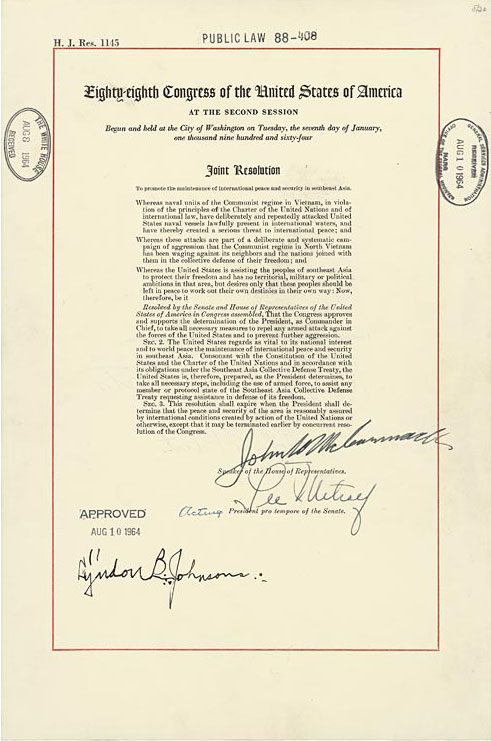
Source: Joint resolution 88-408, Our Documents
On August 7, 1964, just days after the first incident in the Gulf of Tonkin, the US Congress met and passed the Gulf of Tonkin Resolution. Take a look at the document below:

Source: Joint resolution 88-408, Our Documents
This joint resolution of Congress (H.J. RES 1145) dated August 7, 1964, gave President Lyndon Johnson authority to increase U.S. involvement in the war between North and South Vietnam.
The joint resolution "to promote the maintenance of international peace and security in southeast Asia" passed on August 7, with two senators (Wayne Morse and Ernest Gruening) dissenting, and became the subject of great political controversy in the course of the undeclared war that followed.
The Tonkin Gulf Resolution stated that "Congress approves and supports the determination of the President, as Commander in Chief, to take all necessary measures to repeal any armed attack against the forces of the United States and to prevent any further aggression." As a result, President Johnson, and later President Nixon, relied on the resolution as the legal basis for their military policies in Vietnam.
As public resistance to the war heightened, the resolution was repealed by Congress in January 1971.
Did Texas US Senator Yarbrough vote on the resolution? Click on the senate tally sheet to see.
Based on this tally sheet, Senator Yarborough did not vote on this resolution.
![]()
Click on the front page of the New York Times newspaper to read a quote from the article about the Gulf of Tonkin Resolution from August 8, 1964
![]()
Watch footage of the impact of the Gulf of Tonkin Resolution:
![]()
Source: Gulf of Tonkin Resolution, Britannica, YouTube
The Gulf of Tonkin Resolution was vital to events leading to the Vietnam War, but the resolution also impacted the three branches of government. Click on the only branch that can declare war.
Try Again! Correct! Try Again!
Think about our three branches of government - Executive, Legislative and Judicial. How does each branch make sure another branch does not have too much power? Checks and Balances. Remember, the Founding Fathers did not want the president to have too much power and be like a King. So in passing this resolution, Congress transferred the power of declaration of war from the legislative branch to the executive branch.
Read the excerpts from the Gulf of Tonkin Resolution below:
"Congress approves and supports the determination of the President, as Commander in Chief, to take all necessary measures to repeal any armed attack against the forces of the United States and to prevent any further aggression."
This resolution shifted the power of war from one branch of government to another. Describe how power is shifted from one branch to the other. Explain your answer using evidence from the excerpt. Do you think this resolution was necessary based on the Gulf of Tonkin Incident?